One of the main reasons people visit Çeşme is to take the boat over to the Greek island of Chios, little more than 9km away from the Turkish mainland. With the ferry taking only half an hour to make the crossing, it makes a perfect day-trip destination.
The island’s Turkish name means “Mastic Island“, and you’ll understand why when you arrive to find every other item, from liqueurs through chewing gum to cosmetics, made from locally grown mastic.
If you’re only coming for a day you have two choices as to what to do. If you don’t want to rush around then the easiest thing is just to potter about Chios Town, soaking up the historic sights, promenading along the waterfront, shopping for mastic items, then dining in one of the many restaurants and cafes (those who are yearning for pork will find it featuring prominently on local menus).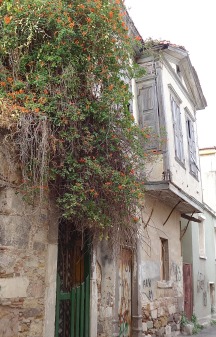
Alternatively you can either hire a car and drive yourself around the main sights of the rest of the island or sign up for a tour that will show you the highlights. Since tours generally run between 11.30am and 5.30pm in high summer you might even be able to combine a bit of the two options.
When to visit: Although you might think that going to Chios for the weekend would be a good idea, really it isn’t since the shops and many of the restaurants close at 2pm on Saturday and don’t open again until Monday morning. Monday is closing day at most of the museums. Ideally, then, you should visit any day from Tuesday to Friday to be able to see everything properly.
Changing money: There are no currency exchange offices on Chios so don’t make the mistake of bringing pounds or dollars and expect to be able to change them other than at one of the banks – which don’t open at weekends, of course.
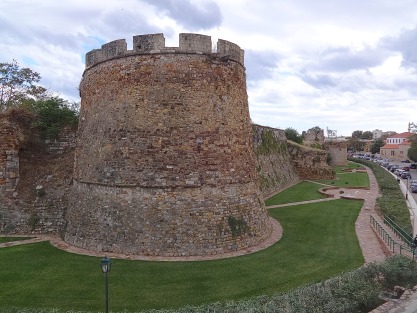 Around Chios Town
Around Chios Town
The most unmissable part of town is the Castro, the huge fortified area to the northeast of the harbour which has a very Turkish feel to it. A lot of EU-sponsored restoration has been carried out here and the work is ongoing.
You enter via the Porta Maggiore, accessed via a stone bridge over a moat. This doglegs around past a tower that stands on the site of what is called Justinian’s Palace. It now houses a small museum of Byzantine and other antiquities found during work in the Castro. A few attractive tiles imported from Spain, Portugal and Turkey and some coffee cups and pieces from waterpipes aside, it’s not very exciting and hardly worth the admission fee. Save your money for the much more impressive Archaeology Museum.
If you follow the path you’ll come to a small square ringed with newish coffeehouses. Tucked in amongst them is an Ottoman graveyard with some fine headstones. Keep walking and you’ll come to the derelict Bayraklı Cami and then to the Church of St George, sadly kept locked outside service times. In its grounds stands an old Ottoman school as well as what looks like a sarcophagus reused as a water container. 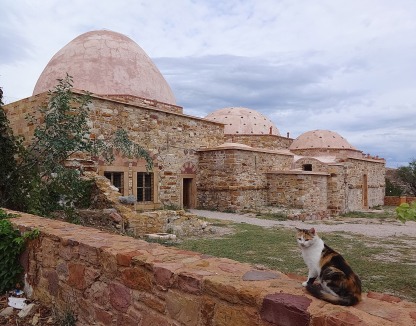
The road continues past houses whose architecture is very like that of Çeşme, Alaçatı and Alsancak in M. Eventually it will bring you to the old hamam, newly restored with some of its original marble basins still in place, some lovely coloured floor tiles and its hypocaust heating system exposed. Unusually the upper walls have carving on them.
The centre of Chios Town is a large square with a beautiful lush park full of palm trees at the back. Facing it is the Mecidiye Cami which has been restored to serve as a beautifully presented Byzantine Museum, its prize pieces giant murals of the saints removed from remote island churches for safety. The original mimber of the mosque is also very lovely.
Also nearby is a small art gallery mainly of interest for the paintings and etchings by local man, Nikos Yalouris (1928-2003).
Elsewhere in town you should also look out for a magnificent Ottoman fountain, the four-sided Melek Mehmet Paş Çeşmesi, dating back to 1768 and a match for anything in İstanbul.
The Archaeological Museum is extremely well laid out and labelled, making it well worth a visit. You’ll need about an hour to explore it.
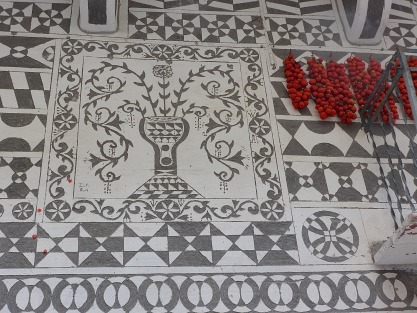 Pirgi (Pyrgi) and Mesta
Pirgi (Pyrgi) and Mesta
Most tours of the island include visits to Pirgi and Mesta, two villages, quite close together, that are both world heritage sites but utterly different in appearance.
Pirgi is known for the extraordinary black-and-white facades of its houses and churches, some of them with images of plants and animals, called xysta, carved into them. The best way to appreciate them is to stay the night in one of the small hotels.
Also worth looking for is the tiny 13th-century Church of the Holy Apostles which is completely covered with frescoes on the inside.
Mesta, in contrast, is a village of lovely stone houses clustered around the huge Taxiarchis church (the older version is more romantically ancient) and a central square full of cafes. Here, too, there are many inviting hotels. 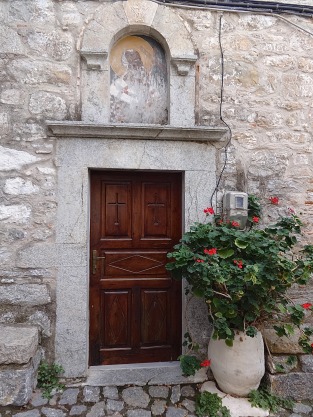
Transport info
Ertürk Lines (tel: 0232-712 6768, www.erturk.com.tr) and Ege Birlik offer daily ferry crossings from Çeşme to Chios. They leave from the Ulusoy Marina, 10 minutes’ walk from the town centre. You have to arrive an hour ahead of the sailing to go through passport formalities so it’s annoying to find that the terminal offers no seating area for its passengers although of course it has duty-free facilities and an over-priced cafeteria.
EU passport-holders can easily continue on from Chios to the rest of Greece and Ertürk can book the onward ferry crossing to Piraeus (for Athens) too. However, they are unable to help with connections to Patras, Bari and Brindisi.
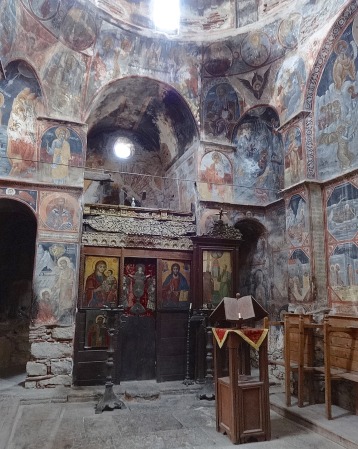 Church of the Holy Apostles, Pirgi
Church of the Holy Apostles, Pirgi


